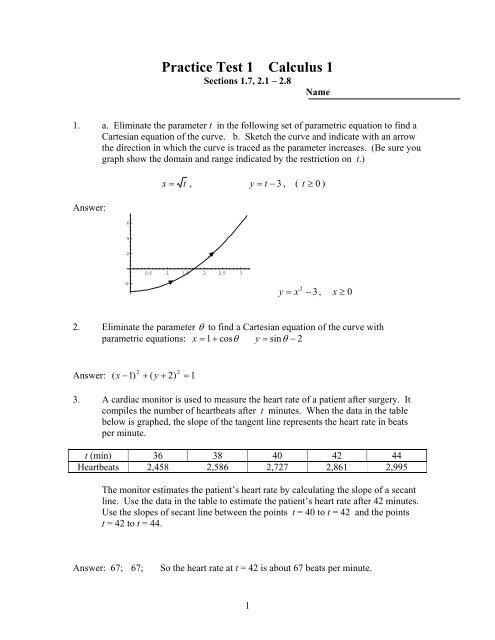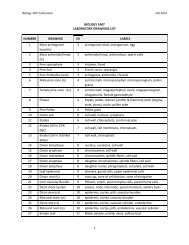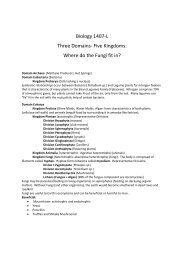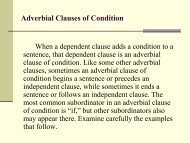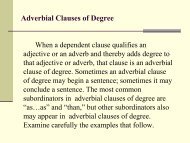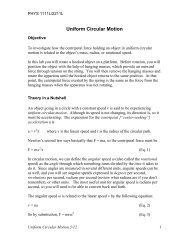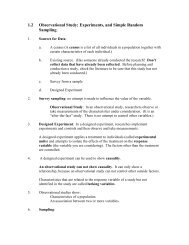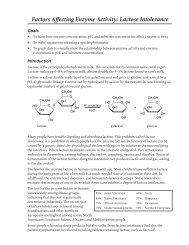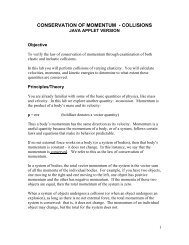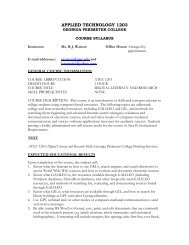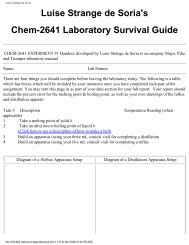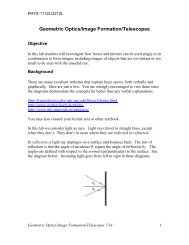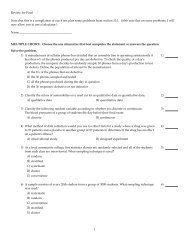Practice Test 1 Calculus 1
Practice Test 1 Calculus 1
Practice Test 1 Calculus 1
Create successful ePaper yourself
Turn your PDF publications into a flip-book with our unique Google optimized e-Paper software.
<strong>Practice</strong> <strong>Test</strong> 1 <strong>Calculus</strong> 1Sections 1.7, 2.1 – 2.8Name1. a. Eliminate the parameter t in the following set of parametric equation to find aCartesian equation of the curve. b. Sketch the curve and indicate with an arrowthe direction in which the curve is traced as the parameter increases. (Be sure yougraph show the domain and range indicated by the restriction on t.)Answer:6x = t , y = t − 3 , ( t ≥ 0 )420.5 1 1.5 2 2.5 3-2y = x 2 − 3, x ≥ 02. Eliminate the parameter θ to find a Cartesian equation of the curve withparametric equations: x = 1+ cosθy = sinθ− 222Answer: ( x −1)+ ( y + 2) = 13. A cardiac monitor is used to measure the heart rate of a patient after surgery. Itcompiles the number of heartbeats after t minutes. When the data in the tablebelow is graphed, the slope of the tangent line represents the heart rate in beatsper minute.t (min) 36 38 40 42 44Heartbeats 2,458 2,586 2,727 2,861 2,995The monitor estimates the patient’s heart rate by calculating the slope of a secantline. Use the data in the table to estimate the patient’s heart rate after 42 minutes.Use the slopes of secant line between the points t = 40 to t = 42 and the pointst = 42 to t = 44.Answer: 67; 67;So the heart rate at t = 42 is about 67 beats per minute.1
4. A rock is dropped from a height of 576 ft and falls toward the earth in a straight2line. In t seconds the rock drops a distance of s = 16t ft.a. Find the average velocity of the rock for the time intervals given below.(i) [5, 5.5] (ii) [5, 5.1](iii) [5, 5.05] (iv) [5, 5.01]b. Use the information above to estimate the instantaneous velocity with t =5 seconds.(Be sure to give the correct units with your answers. Round your answersto one decimal place.)Answer: a. (i) 168 ft/s (ii) 161.6 ft/s (iii) 160.8 ft/s (iv) 160.16 ft/sb. 160 ft/s5. For the function f whose graph is given below , state the value of the givenquantity, if it exists. If it does not exist, explain why.y7654321-2 -1 1 2 3 x-1a. lim f (x) b. lim f (x) c. lim f (x)+ −x→1 x→1 x→1d. f(1) e. lim f ( x)x→ 0Answer: a. 1 b. 6 c. DNE d. 3 e. 32
6. Sketch the graph of an example of a function f that satisfies the followingconditions.f ( 0) = 0, f ( x)= ∞ , f ( x)= −∞ , f ( x)= ∞lim f ( x)=x→∞lim2 x→−lim =lim2 x→2, f ( x)2x→−∞−lim2 x→+Answer:107.552.5-6 -4 -2 2 4-2.5-5-7.5-107. Make a table of values to determine the following limit.2x − 5x+lim−x→3x − 36Answer:x 2 2.9 2.99 2.999 2.9999 2.99999f(x) 0 – 0.9 – 0.99 – 0.999 – 0.9999 – 0.999992x − 5x+lim−x→3x − 36= – 13
8. Apply the limit laws to evaluate each of the following limits, if it exists. If thelimit does not exist, explain why. (For example, does it go to +∞ or −∞ - statewhich-, does it go to different values from the left and from the right?)a. elim2 x→Answer:eb.5xlimx→3 x +2Answer: 3 5 (=15 )5c.limx→−32x + x − 62x − 9Answer: 5/6d.limx→0x + 5 −x5Answer:12 5e.1/ x −1/3limx→3 x − 3Answer:1−92 ⎛ 1 ⎞f. lim x sin⎜⎟ (Use the Squeeze Theorem)x→0⎝ x ⎠4
Answer: 0⎞g. ⎜⎛ 11 + ⎟− ⎝ ⎠lim0x→xAnswer:− ∞ (So it does not exist.)h.limx→+∞2x+ 1x2− xAnswer: 2i.lim3+x→ 3x− xAnswer:− ∞ (So it does not exist.)9. Sketch the graph of the following function and use it to determine the values of xfor which f(x) is discontinuous.⎧3− x if x < −1⎪f ( x)= ⎨xif −1≤ x < 1⎪ 2⎩(x −1)if x ≥ 1Answer:642-4 -3 -2 -1 1 2 3Discontinuous at x = +1 and x = -1.5
10. Write an equation that expresses the fact that a function f is continuous at thenumber 5.Answer: f ( x)= f (5)lim5 x→11. Explain why the following function is continuous at every number in its domain.State its domain.⎛ 1 ⎞f ( x)= ln⎜⎟⎝ x − 6 ⎠Answer: It is the composition of the function g(x) = ln x which is continuous when x > 01and a rational function h(x) = which is continuous except at x = 6. The domain isx − 61x values for which > 0 or x – 6 > 0. So, the domain of f is x > 6.x − 612. Use the Intermediate Value Theorem to show that there is a root to the followingequation in the specified interval. (Be sure to include continuity in yourapplication of the Intermediate Value Theorem. You do not have to find thisroot.)2x − 2 − cos x = 0, ( 0, π )2Answer: Let f(x) = x − 2 − cos x , then f is the difference of x2 − 2 (a polynomialwhich is continuous) everywhere and cos x which is continuous everywhere. Thus, f iscontinuous everywhere and so on [ 0, π ] .2f(0) = -3 and f ( π ) = π −1> 0 So by the Intermediate Value Theorem (since 0 is anintermediate value between -3 and π 2 −1) there exists a c in ( 0, π ) such that f(c) = 0.6
13. Find an equation of the tangent line to the curve y = x at the point (4, 2).(Use either limit definition of the slope of the tangent line to find the slope.)1Answer: y = x + 1414. For the function( ) = + , state a limit that represents f ′(3).2f x x x(Answer:limx→3x2+ x−12x − 3)15. The graph of a function is given below. Which graph, labeled a – d is the graphof its derivative.y0.40.2-6 -4 -2 2 4 6 x-0.2-0.4a. b.15105-6 -4 -2 2 4 6-5-1010.80.60.40.2-15-6 -4 -2 2 4 6c. d.10.58642-6 -4 -2 2 4 6-0.5-1-6 -4 -2 2 4 6-2-47
(Answer: b)16. a. State the definition of the derivative.b. Use this definition to find the slope of a tangent line for the curve y = x−3,at the points P(7, 2).c. Then write the equation for the line tangent to this curve at this point.1(Partial answer: y ' = , slope is ¼ , Equation of the tangent line is2 x − 3y = (1/4) x+ 1/4)117. Find f ′(a)for f ( x)= . (Use either form of the definition of the derivative.)2x− 2Answer: f ′(a)=3a18. The graph of a function f is given below. At what x values is this function notdifferentiable?(Answer: f is not differentiable at x = -2, -1, and 1 It has a vertical tangent line at x =1.)8
19. State whether each of the following statements is true or false.Answer: a. False b. Truea. If a function f is continuous at a point (a, f(a)) then it isdifferentiable there.b. If a function f is differentiable at a point (a, f(a)) then it iscontinuous there.c.20. Sketch the graph of a continuous function f for which f(0) = 0, and f ′(0) = − 2 ,f ′()1 = 0, f ′(2) = 2. (Note that there are many correct answers. Just sketchone.Answer:4321-1 1 2 3-1-221. The following limit represents the derivative of some function f at some numbera. State the function f and the number a.limh→0(2 − h)2h+ 5 − 3Answer: f ( x)= x 2 + 5 , a = 29


